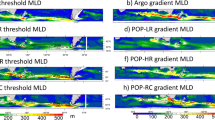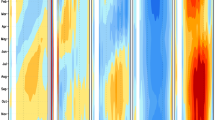Abstract
Recent studies have shown that the shallow meridional circulation (SMC) coexists with the deep circulation in the marine ITCZ. The SMC has been assumed to be forced by strong meridional gradients of Sea Surface Temperature (SST) which affect the atmosphere under hydrostatic balance. In this paper, we present a new viewpoint that the shallow meridional circulation is a part of circulation that forms when the marine ITCZ is located away from the equator. To support this view, we have used reanalysis data over east Pacific ocean to show that the shallow meridional circulation is absent when the ITCZ is located near the equator while it is strong to the south of the ITCZ when the ITCZ is located away from the equator. To further support this view, we have conducted idealized aquaplanet experiments by shifting SST maximum polewards to simulate the observed contrast in the meridional circulation associated with near equatorial and off-equatorial ITCZ. The detailed momentum budget of the flow above the boundary layer shows that, to the south of an off-equatorial ITCZ, the dominant balance between the Coriolis force and the advection of relative vorticity by the mean flow leads to cancellation of the planetary rotational effects. As a result, the net rotational effects experienced by the diverging flow above the boundary layer are negligible and a shallow meridional flow along the pressure gradients is generated. This dominant balance does not occur in the aquaplanet GCM when the ITCZ forms near the equator.










Similar content being viewed by others
References
Berry G Reeder MJ (2014) Objective identification of the intertropical convergence zone: climatology and trends from the ERA-Interim. J Clim 27(5):1894–1909
Blackburn M, Williamson DL, Nakajima K, Ohfuchi W, Takahashi YO, Hayashi YY, Nakamura H, Ishiwatari M, Mcgregor JL, Borth H et al (2013) The aqua-planet experiment (APE): CONTROL SST simulation. 2, 91(0):17–56
Bordoni S, Schneider T (2010) Regime transitions of steady and time-dependent Hadley circulations: comparison of axisymmetric and eddy-permitting simulations. J Atmos Sci 67(5):1643–1654
Bretherton CS, Blossey PN, Khairoutdinov M (2005) An energy-balance analysis of deep convective self-aggregation above uniform SST. J Atmos Sci 62(12):4273–4292
Charney JG (1973) Planetary fluid dynamics. In: Morel P (ed) Dynamic meteorology. Springer, Netherlands, pp 97–351
Collins WD, Rasch PJ, Boville BA, Hack JJ, McCaa JR, Williamson DL, Briegleb BP, Bitz CM, Lin SJ, Zhang M (2006) The formulation and atmospheric simulation of the Community Atmosphere Model version 3 (CAM3). J Clim 19(11):2144–2161
Collins WD, Rasch PJ, Boville BA, Hack JJ, McCaa JR, Williamson DL, Kiehl JT, Briegleb B, Bitz C, Lin SJ et al (2004) Description of the NCAR community atmosphere model (CAM 3.0). Technical Note TN-464+ STR, National Center for Atmospheric Research, Boulder, CO
Dee DP, Uppala SM, Simmons AJ, Berrisford P, Poli P, Kobayashi S, Andrae U, Balmaseda MA, Balsamo G, Bauer P, Bechtold P, Beljaars ACM, van de Berg L, Bidlot J, Bormann N, Delsol C, Dragani R, Fuentes M, Geer AJ, Haimberger L, Healy SB, Hersbach H, Hlm EV, Isaksen L, Kllberg P, Khler M, Matricardi M, McNally AP, Monge-Sanz BM, Morcrette JJ, Park BK, Peubey C, de Rosnay P, Tavolato C, Thpaut JN, Vitart F (2011) The ERA–Interim reanalysis: configuration and performance of the data assimilation system. Q J R Meteorol Soc 137(656):553–597
Gonzalez AO, Rojas GM (2014) Balanced dynamics of deep and shallow Hadley circulations in the tropics. J Adv Model Earth Syst 6(3):777–804
Held IM (2000) The general circulation of the atmosphere, paper presented at 2000 Woods Hole Oceanographic Institute Geophysical Fluid Dynamics Program, Woods Hole Oceanographic Institute, Woods Hole, Mass. Woods Hole Oceanogr. Inst., Woods Hole, Mass. http://gfd.whoi.edu/proceedings/2000/PDFvol2000.html
Hess PG, Battisti DS, Rasch PJ (1993) Maintenance of the intertropical convergence zones and the large-scale tropical circulation on a water-covered earth. J Atmos Sci 50(5):691–713
Machenhauer B (1979) The spectral method. Numerical methods used in atmospheric models. 2(17):121–275
Mitchell TP, Wallace JM (1992) The annual cycle in equatorial convection and sea surface temperature. J Clim 5(10):1140–1156
Murakami T (1992) Contrasts between summer monsoons over the bay of bengal and the eastern north pacific. J Meteor Soc Jpn 70:191–210
Neale RB, Hoskins BJ (2000) A standard test for AGCMs including their physical parametrizations: I: The proposal. Atmos Sci Lett 1(2):101–107
Nolan DS, Powell SW, Zhang C, Mapes BE (2010) Idealized simulations of the intertropical convergence zone and its multilevel flows. J Atmos Sci 67(12):4028–4053
Nolan DS, Zhang C, Chen SH (2007) Dynamics of the shallow meridional circulation around intertropical convergence zones. J Atmos Sci 64(7):2262–2285
Pauluis O (2004) Boundary layer dynamics and cross-equatorial Hadley circulation. J Atmos Sci 61(10):1161–1173
Peters ME, Kuang Z, Walker CC (2008) Analysis of atmospheric energy transport in ERA-40 and implications for simple models of the mean tropical circulation. J Clim 21(20):5229–5241
Plumb RA, Hou AY (1992) The response of a zonally symmetric atmosphere to subtropical thermal forcing: Threshold behavior. J Atmos Sci 49(19):1790–1799
Rienecker MM, Suarez MJ, Gelaro R, Todling R, Bacmeister J, Liu E, Bosilovich MG, Schubert SD, Takacs L, Kim GK et al (2011) MERRA: NASA’s modern-era retrospective analysis for research and applications. J Clim 24(14):3624–3648
Satoh M (1994) Hadley circulations in radiative-convective equilibrium in an axially symmetric atmosphere. J Atmos Sci 51(13):1947–1968
Schneider EK (1977) Axially symmetric steady-state models of the basic state for instability and climate studies. Part II. Nonlinear calculations. J Atmos Sci 34(2):280–296
Schneider EK, Lindzen RS (1977) Axially symmetric steady-state models of the basic state for instability and climate studies. Part I. Linearized calculations. J Atmos Sci 34(2):263–279
Schneider T (2006) The general circulation of the atmosphere. Annu Rev Earth Planet Sci 34(655–688):00136
Schneider T, Bischoff T, Haug GH (2014) Migrations and dynamics of the intertropical convergence zone. Nature 513(7516):45–53
Schneider T, Bordoni S (2008) Eddy-mediated regime transitions in the seasonal cycle of a Hadley circulation and implications for monsoon dynamics. J Atmos Sci 65(3):915–934
Sherwood SC, Bony S, Dufresne J-L (2014) Spread in model climate sensitivity traced to atmospheric convective mixing. Nature 505(7481):37–42
Toma VE, Webster PJ (2010) Oscillations of the intertropical convergence zone and the genesis of easterly waves. Part I: diagnostics and theory. Clim Dyn 34(4):587–604
Tomas RA, Webster PJ (1997) The role of inertial instability in determining the location and strength of near-equatorial convection. Q J R Meteorol Soc 123(542):1445–1482
Trenberth KE, Stepaniak DP, Caron JM (2000) The global monsoon as seen through the divergent atmospheric circulation. J Clim 13(22):3969–3993
Walker CC, Schneider T (2006) Eddy influences on Hadley circulations: Simulations with an idealized GCM. J Atmos Sci 63(12):3333–3350
Wang Y, Xie S-P, Wang B, Xu H (2005) Large-scale atmospheric forcing by southeast pacific boundary layer clouds: a regional model study*. J Clim 18(7):934–951
Williamson DL (2008) Convergence of aqua-planet simulations with increasing resolution in the Community Atmospheric Model, Version 3. Tellus A 60(5):848–862
Williamson DL (2013) Dependence of APE simulations on vertical resolution with the Community Atmospheric Model, version 3. 2, 91(0):231–242
Yang W, Seager R, Cane MA (2013) Zonal momentum balance in the tropical atmospheric circulation during the global monsoon mature months. J Atmos Sci 70(2):583–599
Yokoyama C, Zipser EJ, Liu C (2014) TRMM-observed shallow versus deep convection in the eastern Pacific related to large-scale circulations in reanalysis datasets. J Clim 27(14):5575–5592
Zhang C, McGauley M, Bond NA (2004) Shallow meridional circulation in the Tropical Eastern Pacific. J Clim 17(1):133–139
Zhang C, Nolan DS, Thorncroft CD, Nguyen H (2008) Shallow meridional circulations in the tropical atmosphere. J Clim 21(14):3453–3470
Acknowledgements
We thank Divecha Center for Climate Change for financial support. The discussions with Dr. Ashwin Seshadri were useful.
Author information
Authors and Affiliations
Corresponding author
Additional information
Responsible Editor: J. T. Fasullo.
Rights and permissions
About this article
Cite this article
Dixit, V., Srinivasan, J. The momentum constraints on the shallow meridional circulation associated with the marine ITCZ. Meteorol Atmos Phys 129, 595–609 (2017). https://doi.org/10.1007/s00703-016-0489-2
Received:
Accepted:
Published:
Issue Date:
DOI: https://doi.org/10.1007/s00703-016-0489-2




